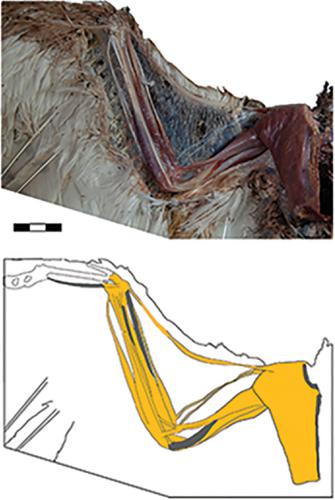当前位置:
X-MOL 学术
›
J. Morphol.
›
论文详情
Our official English website, www.x-mol.net, welcomes your
feedback! (Note: you will need to create a separate account there.)
Wing and tail myology of Tyto furcata (Aves, Tytonidae)
Journal of Morphology ( IF 1.5 ) Pub Date : 2020-02-13 , DOI: 10.1002/jmor.21111 Gastón E Lo Coco 1 , Matías J Motta 1 , María Clelia Mosto 2 , Mariana B J Picasso 2
Journal of Morphology ( IF 1.5 ) Pub Date : 2020-02-13 , DOI: 10.1002/jmor.21111 Gastón E Lo Coco 1 , Matías J Motta 1 , María Clelia Mosto 2 , Mariana B J Picasso 2
Affiliation

|
Barn Owls (Tytonidae) are nocturnal raptors with the largest geographical distribution among Strigiformes. Several osteological, morphometrical, and biomechanical studies of this species were performed by previous authors. Nevertheless, the myology of forelimb and tail of the Barn Owls is virtually unknown. This study is the first detailed myological study performed on the wing and tail of the American Barn Owl (Tyto furcata). A total of 11 specimens were dissected and their morphology and muscle masses were described. Although T. furcata has the wing and tail myological pattern present in other species of Strigiformes, some peculiarities were observed including a difference in the attachment of m. pectoralis propatagialis due to the lack of the os prominence, and the presence of an osseous arch in the radius that seems to widen the anchorage area of the mm. pronator profundus, extensor longus alulae, and extensor longus digiti majoris. Furthermore, the m. biceps brachii has an unusual extra belly that flexes the forearm. The interosseous muscles have a small size and lacks ossified tendons. This feature may be indicative of a lower specialization in the elevation and flexion of the digiti majoris. Forelimb and tail muscle mass account for 10.66 and 0.24% of the total body mass, respectively. Forelimb muscle mass value is similar to the nocturnal (Strigiformes) and diurnal (Falconidae and Accipitridae) raptors, while the tail value is lower than in the diurnal raptors (Falconidae and Accipitridae). The myological differences with other birds of prey are here interpreted in association with their “parachuting” hunting style. This work complements our knowledge of the axial musculature of the American Barn owls, and provides important information for future studies related to functional morphology and ecomorphology.
中文翻译:

Tyto furcata (Aves, Tytonidae) 的翅膀和尾巴肌肉学
仓鸮(Tytonidae)是夜行性猛禽,在剑形目中地理分布最广。以前的作者对该物种进行了几项骨学、形态计量学和生物力学研究。然而,谷仓猫头鹰的前肢和尾巴的肌肉学实际上是未知的。这项研究是对美国谷仓猫头鹰 (Tyto furcata) 的翅膀和尾巴进行的第一次详细的肌学研究。共解剖了 11 个标本并描述了它们的形态和肌肉质量。尽管 T. furcata 具有在其他条纹形目物种中存在的翼和尾肌学模式,但观察到了一些特殊性,包括 m 附着的差异。胸大肌由于缺乏os突出,并且在桡骨中存在一个骨弓,似乎扩大了毫米的锚固区域。旋前深肌、大长伸肌和大趾长伸肌。此外,m。肱二头肌有一个不寻常的额外腹部,可以弯曲前臂。骨间肌体积小,缺乏骨化肌腱。此特征可能表明大指的上抬和屈曲的专业化程度较低。前肢和尾部肌肉质量分别占全身质量的 10.66% 和 0.24%。前肢肌肉质量值与夜行性 (Strigiformes) 和昼行性 (Falconidae 和 Accipitridae) 猛禽相似,而尾部值低于昼行性猛禽 (Falconidae 和 Accipitridae)。与其他猛禽的肌肉学差异在这里被解释为与它们的“跳伞”狩猎风格有关。这项工作补充了我们对美国谷仓猫头鹰轴向肌肉组织的了解,并为未来与功能形态学和生态形态学相关的研究提供了重要信息。
更新日期:2020-02-13
中文翻译:

Tyto furcata (Aves, Tytonidae) 的翅膀和尾巴肌肉学
仓鸮(Tytonidae)是夜行性猛禽,在剑形目中地理分布最广。以前的作者对该物种进行了几项骨学、形态计量学和生物力学研究。然而,谷仓猫头鹰的前肢和尾巴的肌肉学实际上是未知的。这项研究是对美国谷仓猫头鹰 (Tyto furcata) 的翅膀和尾巴进行的第一次详细的肌学研究。共解剖了 11 个标本并描述了它们的形态和肌肉质量。尽管 T. furcata 具有在其他条纹形目物种中存在的翼和尾肌学模式,但观察到了一些特殊性,包括 m 附着的差异。胸大肌由于缺乏os突出,并且在桡骨中存在一个骨弓,似乎扩大了毫米的锚固区域。旋前深肌、大长伸肌和大趾长伸肌。此外,m。肱二头肌有一个不寻常的额外腹部,可以弯曲前臂。骨间肌体积小,缺乏骨化肌腱。此特征可能表明大指的上抬和屈曲的专业化程度较低。前肢和尾部肌肉质量分别占全身质量的 10.66% 和 0.24%。前肢肌肉质量值与夜行性 (Strigiformes) 和昼行性 (Falconidae 和 Accipitridae) 猛禽相似,而尾部值低于昼行性猛禽 (Falconidae 和 Accipitridae)。与其他猛禽的肌肉学差异在这里被解释为与它们的“跳伞”狩猎风格有关。这项工作补充了我们对美国谷仓猫头鹰轴向肌肉组织的了解,并为未来与功能形态学和生态形态学相关的研究提供了重要信息。











































 京公网安备 11010802027423号
京公网安备 11010802027423号